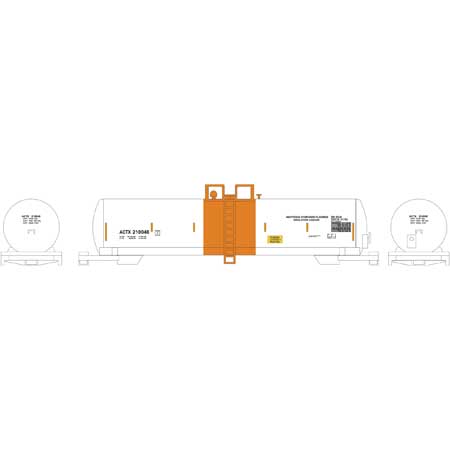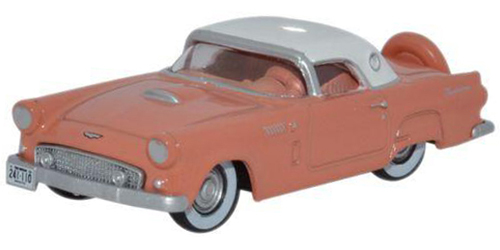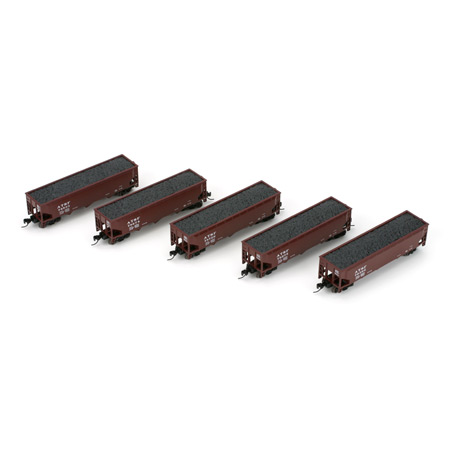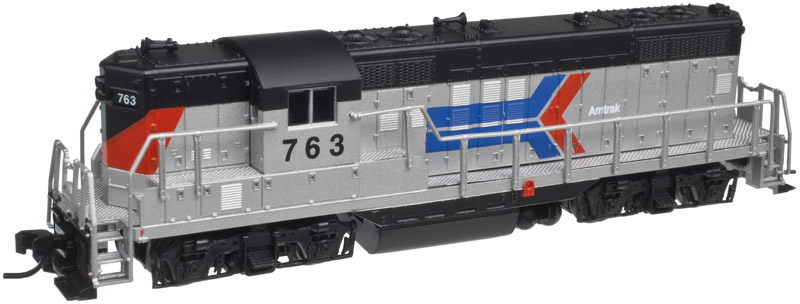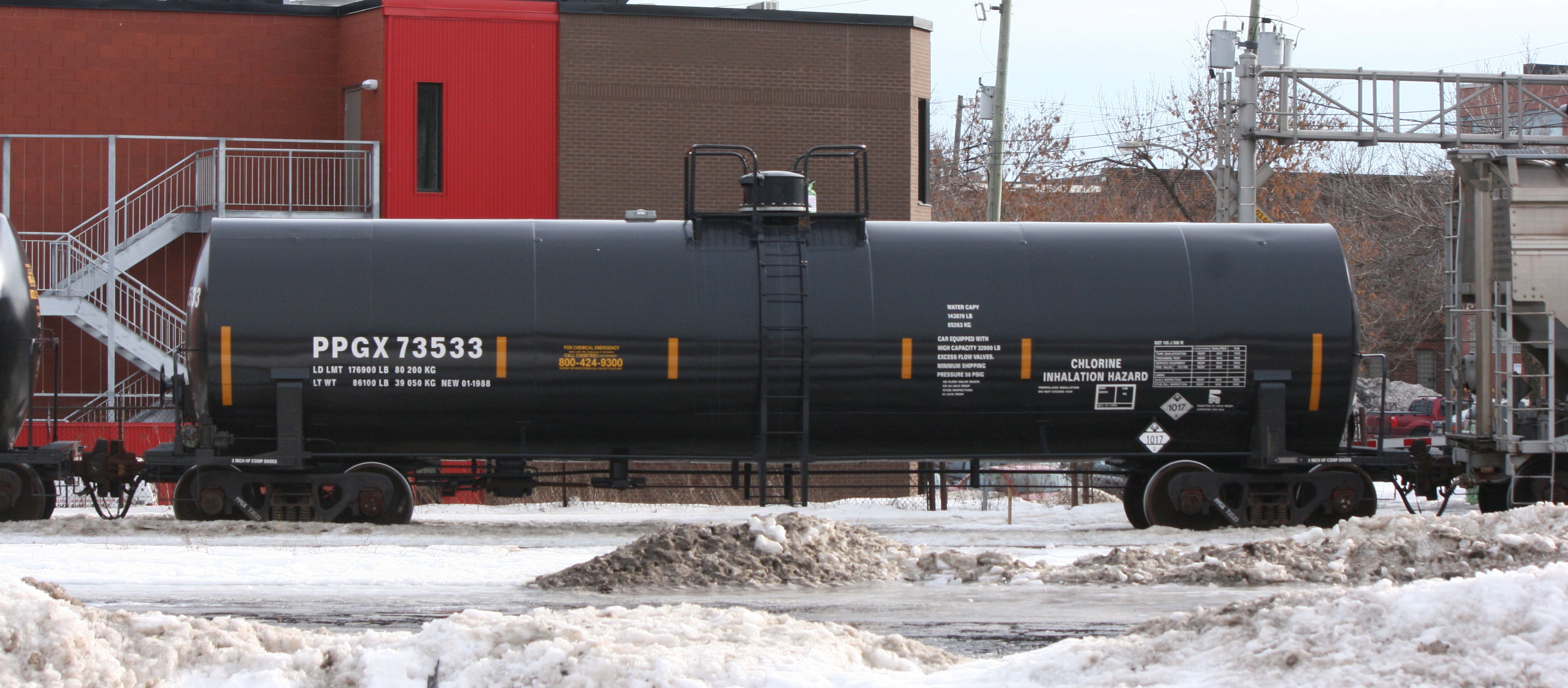Model Information: Model Introduced: 2006. Era: 1970s to Present. This car models a steel tank car produced by the Richmond Tank Car company of Texas between 1954 and 1969. The model features: Photo-etched platforms, Factory installed wire grab irons, Weighted for optimum performance, Machined RP25 profile metal wheels, Equipped with McHenry AAR upper/lower shelf couplers per prototype practice.
Prototype History: Larger, 50' Tank cars replaced their smaller predecessors in the late 1960s and 1970s. The Richmond Tank Car Company was one of several manufacturers to produce these general purpose railcars. They generally had about 20,000 gallon capacity and were used to transport many different commodities.
Road Name History: 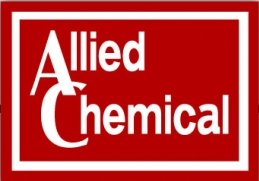 Allied Corp. was a major American company with operations in the chemical, aerospace, automotive, oil and gas industries. It was initially formed in 1920 as the Allied Chemical and Dye Corporation as an amalgamation of five chemical companies. In 1958 it was renamed Allied Chemical Corporation when it diversified into oil and gas exploration. Allied Chemical then became Allied Corporation in 1981. In 1985 Allied merged with the Signal Companies to become AlliedSignal. AlliedSignal would eventually acquire Honeywell in 1999 and then adopt its name.
Allied Corp. was a major American company with operations in the chemical, aerospace, automotive, oil and gas industries. It was initially formed in 1920 as the Allied Chemical and Dye Corporation as an amalgamation of five chemical companies. In 1958 it was renamed Allied Chemical Corporation when it diversified into oil and gas exploration. Allied Chemical then became Allied Corporation in 1981. In 1985 Allied merged with the Signal Companies to become AlliedSignal. AlliedSignal would eventually acquire Honeywell in 1999 and then adopt its name.
In 1920, publisher Eugene Meyer and noted chemist William Ripley Nichols founded Allied Chemical and Dye Corporation in order to address this shortcoming in American industrial production. Allied was an amalgamation of five existing companies (with capitalization of $175,000,000), including the Standard Aniline Products Corporation and National Aniline and Chemical Works. All manufacturing was consolidated in Buffalo, and much attention was given to improving the processes hastily introduced during World War I. Allied's first venture into new markets was the construction of a synthetic ammonia plant near Hopewell, Virginia in 1928. This would soon become the world's largest producer of ammonia.
From Wikipedia

In 1920, publisher Eugene Meyer and noted chemist William Ripley Nichols founded Allied Chemical and Dye Corporation in order to address this shortcoming in American industrial production. Allied was an amalgamation of five existing companies (with capitalization of $175,000,000), including the Standard Aniline Products Corporation and National Aniline and Chemical Works. All manufacturing was consolidated in Buffalo, and much attention was given to improving the processes hastily introduced during World War I. Allied's first venture into new markets was the construction of a synthetic ammonia plant near Hopewell, Virginia in 1928. This would soon become the world's largest producer of ammonia.
From Wikipedia
Brand/Importer Information: Athearn's history began in 1938, when its founder-to-be, Irvin Athearn, started an elaborate O scale layout in his mother's house. After placing an ad selling the layout, and receiving much response to it, Irv decided that selling model railroads would be a good living. He sold train products out of his mother's house through most of the 1940s. After becoming a full-time retailer in 1946, Irv opened a separate facility in Hawthorne, California in 1948, and that same year he branched into HO scale models for the first time.
Athearn acquired the Globe Models product line and improved upon it, introducing a comprehensive array of locomotive, passenger and freight car models. Improvements included all-wheel drive and electrical contact. One innovation was the "Hi-Fi" drive mechanism, employing small rubber bands to transfer motion from the motor spindle to the axles. Another was the double-ended ring magnet motor, which permitted easy connection to all-wheel-drive assemblies. Athearn was also able to incorporate flywheels into double-ended drives.
The company produced a model of the Boston & Maine P4 class Pacific steam locomotive which incorporated a cast zinc alloy base and thermoplastic resin superstructure. It had a worm drive and all power pickup was through the bipolar trucks that carried the tender. This item was discontinued after the Wilson motor was no longer available, and was not redesigned for a more technologically advanced motor.
Athearn's car fleet included shorter-than-scale interpretations of passenger cars of Southern Pacific and Atchison, Topeka & Santa Fe Railroad prototypes. The company also offered a variety of scale-length freight cars with sprung and equalized trucks. The cars could be obtained in simple kit form, or ready-to-run in windowed display boxes. The comprehensive scope of the product line contributed to the popularity of HO as a model railroad scale, due to the ready availability of items and their low cost.
Irv Athearn died in 1991. New owners took control in 1994, but continued to follow Athearn's commitment to high-quality products at reasonable prices. Athearn was bought in 2004 by Horizon Hobby. Athearn was then moved from its facility in Compton to a new facility in Carson, California. In mid-2009, all remaining US production was moved to China and warehousing moved to parent Horizon Hobby. Sales and product development was relocated to a smaller facility in Long Beach, California.
Read more on Wikipedia and Athearn website.
Athearn acquired the Globe Models product line and improved upon it, introducing a comprehensive array of locomotive, passenger and freight car models. Improvements included all-wheel drive and electrical contact. One innovation was the "Hi-Fi" drive mechanism, employing small rubber bands to transfer motion from the motor spindle to the axles. Another was the double-ended ring magnet motor, which permitted easy connection to all-wheel-drive assemblies. Athearn was also able to incorporate flywheels into double-ended drives.
The company produced a model of the Boston & Maine P4 class Pacific steam locomotive which incorporated a cast zinc alloy base and thermoplastic resin superstructure. It had a worm drive and all power pickup was through the bipolar trucks that carried the tender. This item was discontinued after the Wilson motor was no longer available, and was not redesigned for a more technologically advanced motor.
Athearn's car fleet included shorter-than-scale interpretations of passenger cars of Southern Pacific and Atchison, Topeka & Santa Fe Railroad prototypes. The company also offered a variety of scale-length freight cars with sprung and equalized trucks. The cars could be obtained in simple kit form, or ready-to-run in windowed display boxes. The comprehensive scope of the product line contributed to the popularity of HO as a model railroad scale, due to the ready availability of items and their low cost.
Irv Athearn died in 1991. New owners took control in 1994, but continued to follow Athearn's commitment to high-quality products at reasonable prices. Athearn was bought in 2004 by Horizon Hobby. Athearn was then moved from its facility in Compton to a new facility in Carson, California. In mid-2009, all remaining US production was moved to China and warehousing moved to parent Horizon Hobby. Sales and product development was relocated to a smaller facility in Long Beach, California.
Read more on Wikipedia and Athearn website.
Item created by: Jenna on 2018-09-06 17:15:46. Last edited by gdm on 2022-08-09 06:50:46
If you see errors or missing data in this entry, please feel free to log in and edit it. Anyone with a Gmail account can log in instantly.
If you see errors or missing data in this entry, please feel free to log in and edit it. Anyone with a Gmail account can log in instantly.


